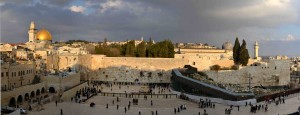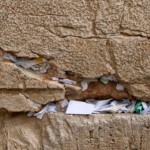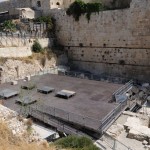Nothing New, Really
Posted on September 20, 2013 by David Bogomolny
Tags: disappointment, feminism / women, Israel, Israeli culture, politics, the Diaspora, The Old City of Jerusalem, The Western Wall / The Kotel, Women of the Wall

When Jessica Baverman recently wrote about her developing relationship to the Kotel, I was reminded of some of my thoughts about and feelings towards it. I remember reading Avi Spodek’s post last spring, appreciating his struggle, and agreeing with him that “the incidents at the Kotel these past few months have dominated the atmosphere” at Pardes. My friend Andrea Wiese‘s passion for the Kotel has affected me, but she’s hardly the only Jew I’ve heard discussing it, writing about it, or attending Women of the Wall (WOW) prayer services. And so, as I live within convenient walking distance of the Kotel, I’ve also come to think about it quite a lot.
In truth, having read a lot of online forums where nobody convinces anybody else of their opinions, and a lot of feelings get riled up, I don’t think I have much to add to this conversation that hasn’t been written by somebody else. Still, I can’t seem to stop contemplating it, as I literally pray at the Kotel every Saturday morning, and also prayed there recently on Rosh HaShana and Sukkot (I also wanted to pray there on Yom Kippur, but I decided that it was much too hot outside in Jerusalem).
I’m not affiliated with WOW, and I’m not affiliated with their detractors. Still, if I had to vote, I would vote to allow women to wear tallitot and tefilin at the Kotel (despite have some sympathies towards those who find this very idea threatening). It’s in the above context that I’d like to share the following thoughts:
- Is the Kotel an Orthodox synagogue, or is it a national monument? This is a major discussion point that comes up over and over again in the forums that I read.
Perhaps my all-time favorite tour in Israel was run by Jared Goldfarb – he called it the “Four Quarters” tour. Rather than focusing on the history of the Old City of Jerusalem, he focused on its residents & their daily realities – we walked through each of the four quarters, met with some of their representatives and discussed the Old City from their perspectives – it was an angle that I’d never really considered until then. I mention this because one of the issues we discussed with Jared was that the Jewish residents of the Old City are now almost all ultra-Orthodox, and it’s entirely natural for them to regard the Kotel as a local synagogue – after all, many of them pray there every single day.
 Still, none of the prayer goers at the Kotel bat an eyelash on Shabbat (or during the week) when groups of (non-Jewish) tourists walk through and around the Jewish prayer quorums, up to the wall, press themselves against it and insert their personal notes to G-d into the crevices between its stones. This behavior would never be acceptable at any other “Orthodox synagogue” … so why is this accepted at the Kotel? I believe that there are very strong grounds to support the idea that the Wall is, indeed, a national monument.
Still, none of the prayer goers at the Kotel bat an eyelash on Shabbat (or during the week) when groups of (non-Jewish) tourists walk through and around the Jewish prayer quorums, up to the wall, press themselves against it and insert their personal notes to G-d into the crevices between its stones. This behavior would never be acceptable at any other “Orthodox synagogue” … so why is this accepted at the Kotel? I believe that there are very strong grounds to support the idea that the Wall is, indeed, a national monument.
- Many of the people who attend the monthly WOW Rosh Chodesh prayer services do not pray or wear tallitot and tefilin on a regular basis. Therefore, the argument goes, their intentions towards the Kotel are insincere and less authentic than those of the Jews who are committed to a traditional, thrice daily prayer practice.
This perspective is based upon the idea that Judaism is defined by halakha (Jewish religious law). As I once wrote, I believe that Judaism ≠ halakha, but halakha is the backbone of the Jewish People. So I’m very committed to halakhic thought and practice, but believe that “Judaism” also includes our culture, history, language, and many other components besides the beautiful, critically important halakhic system, which has long sustained our nation.
As I’ve also written, I don’t believe that non-Orthodox Jews are somehow less Jewish than I am, nor do I believe that their Jewish identities are somehow less authentic than mine – so if a Jew has a strong affinity towards the Kotel, but doesn’t pray three times a day and regularly don tallit and tefilin, I would simply say that xe (gender neutral pronoun) connects to Judaism differently than I do – but not in a less authentic or meaningful way.
- But, for me, there’s a rub. Many (probably most) of the people who attend the monthly WOW services on Rosh Chodesh do not actually live in Israel, and they are dramatically outnumbered by their Orthodox detractors. So while I don’t necessarily consider any Jew’s connection to the Kotel less legitimate than another’s, there does seem to be a marked lack of commitment to the WOW cause among the non-Orthodox Israeli population.
But should this matter? Honestly, I’m not sure.
I am fairly certain that if a majority of non-Orthodox Israelis (or at least enough to outnumber the WOW opponents) proactively supported this cause, the reality would change. Even without this kind of support, an Israeli court has already ruled that “there was no basis for arresting women over wearing tallitot or performing rites [at the Kotel] not in accordance with Orthodox custom.” Yet the conflict has continued “on the ground” with Orthodox school girls being bussed in by their religious leaders to crowd out the WOW from praying inside the women’s prayer section; and this has occurred several times since.

Egalitarian Prayer Platform
Of course, I’ll still be thinking about this tomorrow on Shabbat morning – at the Kotel.
 Still, none of the prayer goers at the Kotel bat an eyelash on Shabbat (or during the week) when groups of (non-Jewish) tourists walk through and around the Jewish prayer quorums, up to the wall, press themselves against it and insert their personal notes to G-d into the crevices between its stones. This behavior would never be acceptable at any other “Orthodox synagogue” … so why is this accepted at the Kotel? I believe that there are very strong grounds to support the idea that the Wall is, indeed, a national monument.
Still, none of the prayer goers at the Kotel bat an eyelash on Shabbat (or during the week) when groups of (non-Jewish) tourists walk through and around the Jewish prayer quorums, up to the wall, press themselves against it and insert their personal notes to G-d into the crevices between its stones. This behavior would never be acceptable at any other “Orthodox synagogue” … so why is this accepted at the Kotel? I believe that there are very strong grounds to support the idea that the Wall is, indeed, a national monument.